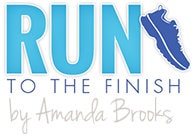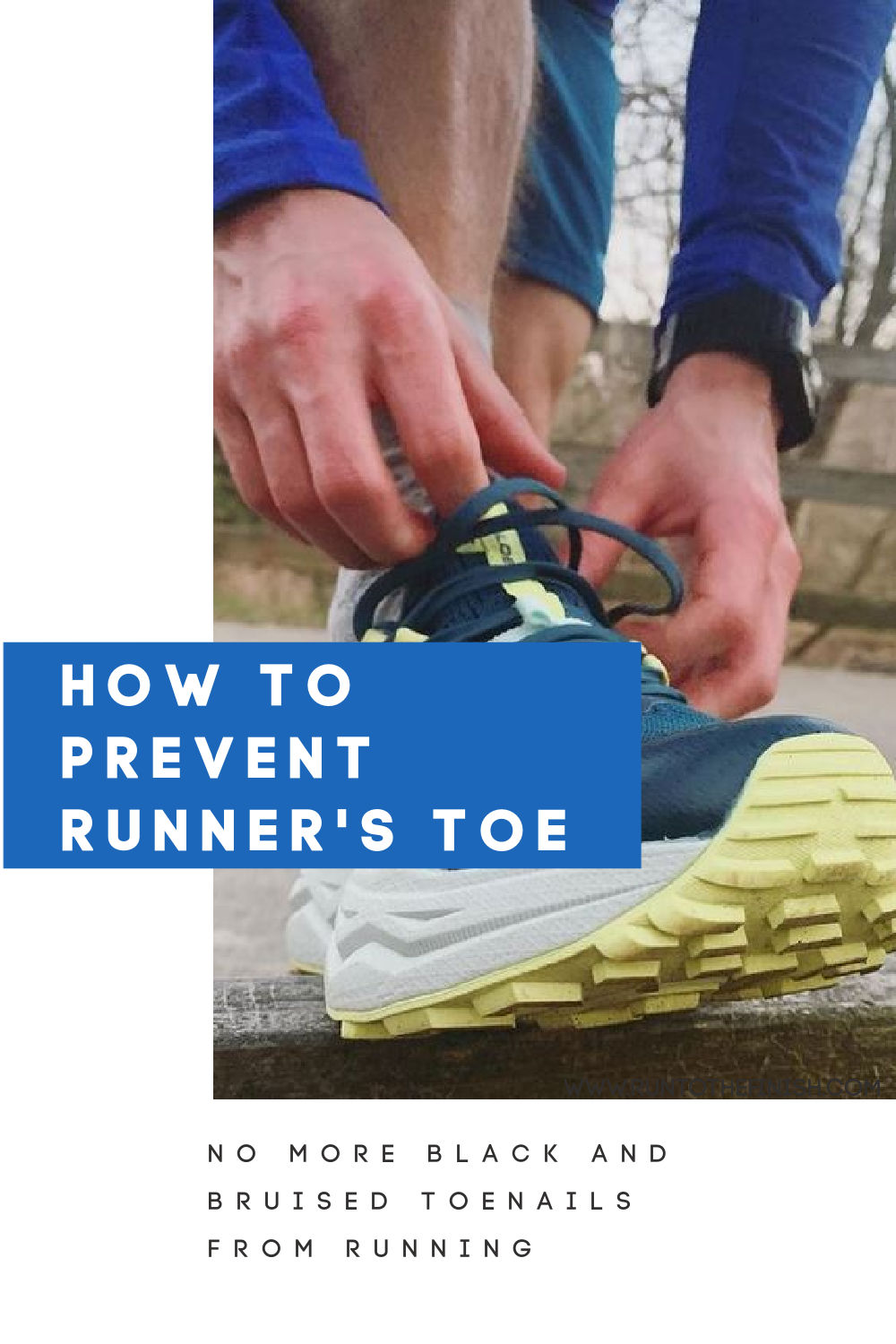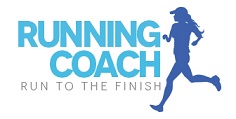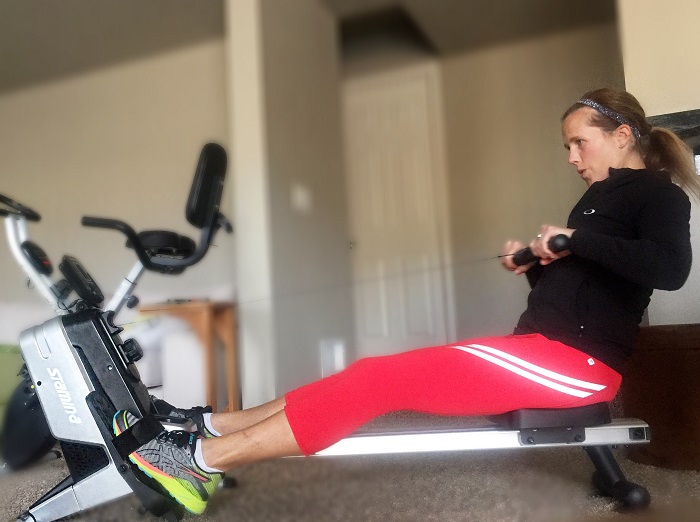Let’s start with this, Runner’s Toe (aka black toenails from running) is not required to be in the club and is not a 100% certainty for all runners.
We often treat our injuries like war stories. Each runner has the toenail they’ve lost, the race they pushed through when they shouldn’t have and all of it makes it seem like running is really taking a toll on the body.
But of course, we know that it doesn’t have to! The same goes for your toes.
In this article, we’ll discuss everything you need to know about Runner’s Toe, along with what you can do to prevent it from ever happening to you as a runner or treat it if you have it at this very moment.
What Is Runner’s Toe?
A runner’s toe (also known as runner’s toenail or jogger’s toenail) is what happens to many athletes especially runners when their toenail turns black from a repetitive sport or activity.
The area under or around the toenail begins to turn dark purple or black and can happen when your toe repeatedly slams into your shoe or rubs against it.
These repetitive microtraumas, from the impact of the toe hitting the soft interior of the shoe, cause a microscopic amount of damage each time.
Since running is a repetitive sport, this results in repetitive trauma. And these microtraumas eventually add up leading to bleeding under your nail, which then starts to look black.
Medically, this condition is known as subungual hematoma.
Subungual literally means under the nail, while hematoma means a collection of blood outside of blood vessels.
The bleeding can sometimes lead to an overall increase in blood flow to the area, which then results in your foot starting to swell. This further exacerbates the problem when now, due to the swelling, your toe starts to rub against your shoe even more.
Why are Runners More Prone to Runner’s Toe?
The repetitive nature of running as a sport really contributes to how much more likely runners are to suffer some runner’s toe (hence the name!).
The foot is moving in your shoe with every single stride you take, and the foot is producing tremendous force into the ground.
- A too-tight toe box means that with each step the shoe is compressing the top of the foot, which often leads not just to toe issues, but top of foot issues (see wide toebox running shoes)
- A too-big shoe means with each step your foot moves forward and hits the front of the shoe
- Downhill running also presses the foot forward in the shoe (consider toecaps or padding)
What are the Symptoms of Runner’s Toe?
Some of the symptoms you can expect if you have runner’s toe are:
- Throbbing pain in the toenail
- Purple, or black discoloration under some or all of the nail
- Redness and swelling around the head of the toe
- Tenderness around the affected toenail
If you have a runner’s toe, you might first start off by experiencing some discomfort. You might then notice redness and swelling around the head of the toe.
The toe might then start to feel tender to the touch; as pressure from the bleeding builds up, you may experience some pain when you apply a little pressure to it.
In most cases, the pain will ease up in a day or two. This pain might feel more severe to some people suffering from runner’s toe, depending on the amount of pressure that’s building up under the toenail from the bleeding.
Sometimes, the nail will start to lift upwards from all the pressure from the blood underneath. The nail often also thickens and comes brittle before falling off altogether.
Other Reasons Why Your Toenail Has Turned Black
Toenail fungus could be the other reason why your toenail has turned black. Runners can also be prone to fungal infections because fungi tend to thrive in moist environments, such as sweaty toes.
Onychomycosis is one such fungal infection that can cause a yellow-brown discoloration in your nail bed. It may also lead to debris build-up under the nail which leads to darkness and discoloration
If you suspect you have a fungal infection instead of runner’s toe, head to your doctor. They will let you know what the best treatment is for your particular case, which might include over-the-counter or prescription medication.
How to Treat Runner’s Toe
Let the nail grow out
If the pain eases after a day or two, there is no reason to worry. Most cases of runner’s toe will not require you to do much. Usually, the nail will simply grow out with the nail plate and the condition will resolve on its own.
In such cases, expect the nail to remain discolored anywhere from a few weeks to a few months depending on how fast your toenails grow. It might then eventually fall off and you’ll notice a new one growing in its place underneath it.
Why do runners lose toenails?
Don’t worry since the toenail falling off is common when you have a mild case of runner’s toe.
Usually, after this damage has occurred, the body starts to grow a new toenail.
Eventually, it pushes off the dead toenail…or sometimes the dead toenail comes off before you have that new one.
If this happens and there isn’t any bleeding, apply an antibiotic ointment to the exposed nail bed. This is again why the toe caps can become a good tool (see more below).
Keep an eye out for signs of infection
Like I mentioned above, in most cases, the pain from runner’s toe will ease up in a day or two.
This pain might feel more severe to some people suffering from runner’s toe, depending on the amount of pressure that’s building up under the toenail from the bleeding.
If even after two to three days you’re still experiencing a lot of pain and swelling, it could be a sign that your toenail is infected.
Signs of an infection:
- some bad smell
- oozing pus
- along with the sharp pain
- swelling
- possible fever because of an infection
If you’re experiencing all these symptoms, then it’s time to head to the doctor straight away.
Get a podiatrist to drain it
If your toenail is infected after you’ve suffered from runner’s toe, you can visit your local doctor’s office for a procedure known as nail trephination.
This procedure is meant to drain the extra fluid from the wound.
Your doctor, usually a podiatrist, may use a heated needle to make a small hole in your nail to drain out the blood in a clean, sterile manner.
You may be tempted to try doing this yourself, but please don’t. This may lead to infections and cause further problems if bacteria get trapped in there accidentally. My suggestion would be to always head to your local doctor instead.
Signs you need to head to the doctor again
Once you’ve gotten the blood drained and followed all the instructions from your doctor, the toenail should start healing and the pain should subside within a few days.
If, however, you’re still experiencing a lot of pain days after it has been drained, it may be a sign you need to head to the doctor again.
This is especially true if you have any of the following symptoms after getting it drained:
- The nail doesn’t stop bleeding
- It still looks or feels infected
- The swelling and redness seem to have gotten worse
- You notice that the base of the nail is damaged or there’s a deep cut
- You notice pus or fluid oozing out of the nail
- You’re experiencing a throbbing pain or heat in the toe
- You’re having a fever
If this is what’s happening to you this very moment, don’t worry and head to a doctor straight away! You might be prescribed some medication to treat the infection.
The doctor will also check to see what other treatment options are viable for you – which might involve removing the nail entirely or stitching up the cut.

Should you cut a black toenail?
NO. You will end pulling off live skin, creating an additional problem and an area now prone to infection from being constantly damp with sweat.
If the bruised toenail is painful and creating a lot of pressure, you can attempt to alleviate it much like a blister.
- Sterilize a needle
- Try to get the needle just under the toenail where you see a volume of fluid and create a small puncture allowing fluid to release
- Apply Neosporin or another anti-bacterial cream
- You can try to cover the nail with a Compeed for your toe, they tend to stay on better than a band-aid
- Once you are done running and in a clean place, try giving the area time to air out by not using any covering
If the area of pressure is right in the middle of the toenail and not near the edge, the treatment starts to feel a bit more intense. One of the most common recommendations is:
- heat a paperclip
- place the hot end on the nail and let it melt through the nail
- this creates a hole for the fluid to escape
- follow the above tips to prevent infection
If you are doing ANY of these during a race please, please follow a few rules:
- You have to keep cleaning the area and putting on anti-bacterial so it doesn’t become a bigger issue
- Don’t take pain relievers and run – they cause liver damage and have been shown in ultra runners to actually create leg fatigue. Try something like Turmeric pills instead to fight the pain and inflammation.
7 Ways to Effectively Prevent Runner’s Toe
The best treatment is always prevention first.
How do you treat runner’s knee, you add in a lot more glute and hip strength. When it comes to your toes step 1 is to prevent the bruising or loss of the toenail.
Let’s look at 7 ways to effectively prevent runner’s toe from ever occurring in the first place:
1. Wear the Right Shoes
The best way to prevent runner’s toe is to wear shoes that properly fit you. Make sure that your shoes aren’t too tight. It’s a good idea to have some space between your big toe and the end of your shoe.
Another tip: shop for shoes at the end of the day when feet are at their largest
Checkout these running shoes for wide feet >>
2. Keep your Toenails Short
Trimming your nails short will ensure your nail doesn’t hit inside your shoe’s toe box, and when it does happen it’ll be your toe that hits it and not your toenail.
By keeping your toenails nice and short, it’ll make sure your nails don’t rub against the inside of your shoes regularly. Moderation is key here though – don’t cut them so short that you risk the chance of having an ingrown nail.
3. Use Toe Caps to Protect the Toes
Whether you have lost the toenail or are trying to prevent issues from a big downhill race, toe caps can be an option.
The big thing is to ensure you don’t create new problems by adding bulk to your shoe or rubbing on other toes creating pain or blisters.
- Pro-Tec is one of the most commonly recommended silicone gel toe caps, likely because it’s thin.
- You don’t want to wear them on all toes, so pick the ones you most often have issues with (usually a big toe for downhills or if you have a longer toe)
- Some folks like to wear these with the Injini toe socks for a little added comfort that they will stay firmly in place
- Definitely look at sizing – I haven’t tested these but I know sizing is one thing to consider when getting a good fit (i.e. do they have Big toe vs other toe options like Zen Toes).
4. Wear Moisture-Wicking Socks
Having sweaty socks, and hence a moist environment is a recipe for disaster when it comes to fungal infections (like we discussed above).
Moreover, damp toes or feet can also lead to your feet sliding in the shoe and your toes hitting the shoe.
You can prevent this by wearing moisture-wicking socks. But make sure to pick ones that are thin, and don’t add extra bulk to your feet.
If they’re bulky, you’ll be creating another problem altogether and your toes will rub against the inside of your shoes instead of preventing this.
Also, stop wearing super thick socks in general as they tend to create too much pressure inside the shoe and cause further problems resulting in runner’s toe.
PLUS, make sure you’re using one of the best chafing creams on my list. That’s going to provide some additional glide, which can prevent all kinds of issue.
5. Tie Your Shoes Correctly
Lacing up your shoes properly is essential to ensure your foot doesn’t slide inside your shoe each time your foot hits the ground.
Running and especially distance running requires extra attention to be paid to the way you lace up your shoes to keep your heels as steady as possible. This can also prevent other injuries such as ankle sprains.
There is also a research study published in December 2008 in the Journal of Sports Sciences that studies six different lacing conditions to and their impact on the biomechanics of running shoes.
This study mentions that a firm foot-to-shoe coupling with higher lacing leads to more effective use of running shoe features and is likely to reduce the risk of lower limb injury and prevent the foot from sliding inside the shoe.
So next time you tie your shoelaces, try to tie them in different ways to see how stable it keeps your heels or adds more room to the toebox and how it affects your running form.
✅Checkout this article for details on how to lace running shoes to reduce pain.
6. Don’t Increase Mileage Too Quickly
Increasing mileage too quickly can also cause an issue because of the pounding in your feet and the pressure required for push-off.
If you’re looking to increase your mileage safely and consistently, you can do so in 5 to 10% increments.
Many people like to follow the 10% rule to increase running mileage. That’s the process we follow for the majority of our athletes to avoid injury.
7. Work on Your Technique
Many times, the problem that leads to a runner’s toe is running with an incorrect form or by using the wrong techniques. New runners are more likely to suffer from such injuries for this reason.
Having a running coach guide you and correct your technique is a great way to ensure you not only reduce your chances of ever suffering from runner’s toe, but also some other types of injuries.
What to Do to Ensure Full Recovery from Runner’s Toe?
Even if you’ve suffered from runner’s toe, it doesn’t need to necessarily set you back much time at all.
Reduce your mileage
Get the right shoes
Protect your toes
Cut back on downhill runs
You’ll be back to training before you know it! Work on your technique till then and follow all the prevention methods listed in this article to reduce the chance of injury in the future.
Looking for more to treat your feet right?
- 11 Common Causes of Running Foot Pain
- How to prevent running blisters (and what to do if they happen)
- Should you use running insoles?
- When to replace your running shoes?
Other ways to connect with Coach Amanda
Instagram Daily Fun: RunToTheFinish
Facebook Community Chatter: RunToTheFinish
Sign Up to Receive a Weekly Newsletter with Top Running Tips and Laughs






 Rowing vs Running: Which Workout is Better?
Rowing vs Running: Which Workout is Better?